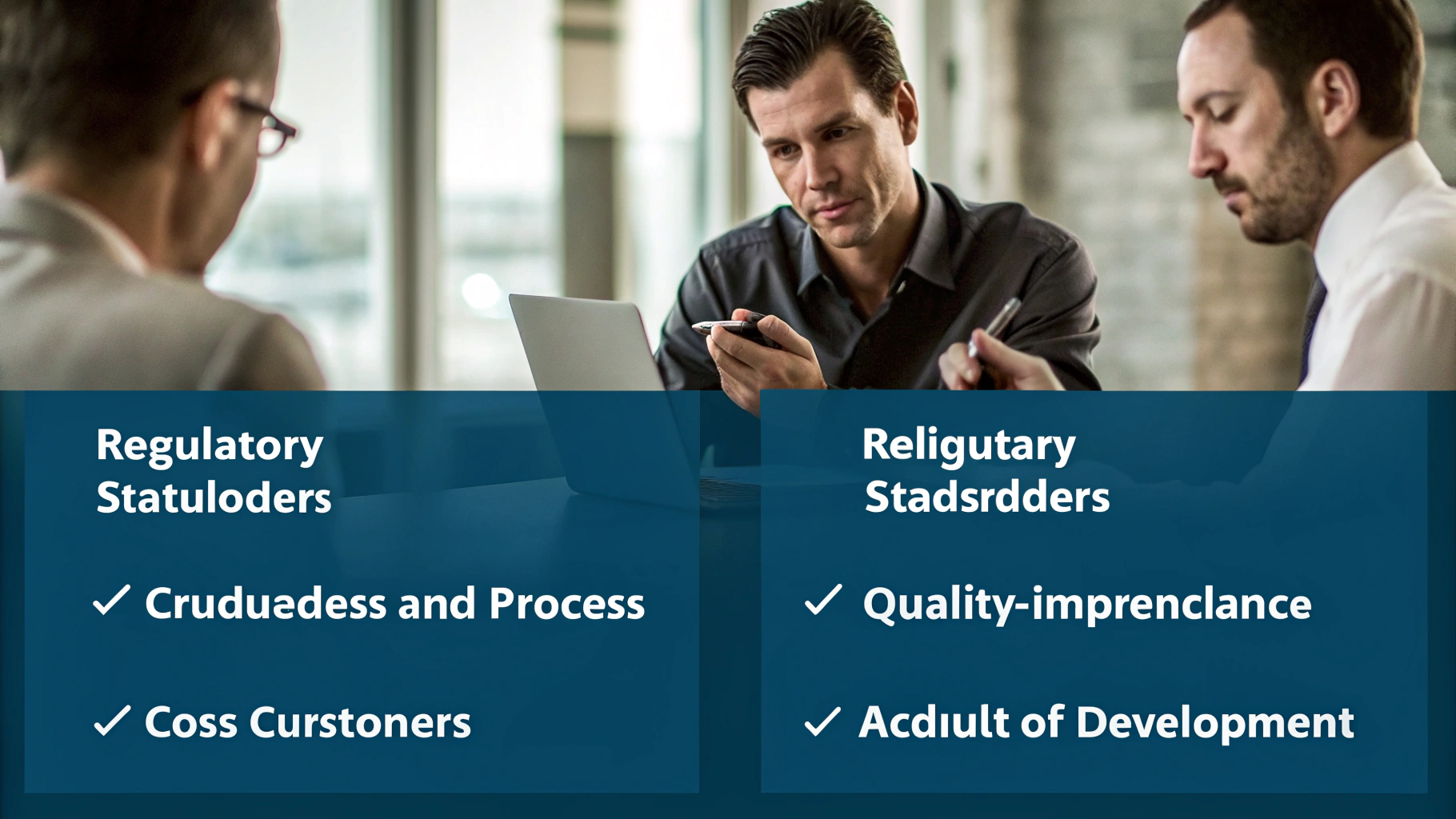Mastering Regulatory Strategy for Drug Development Compliance

Introduction
Navigating the complex landscape of drug development demands a sharp understanding of the regulatory framework that governs the industry. Organizations face the dual challenge of adhering to stringent guidelines while also leveraging these regulations as a strategic advantage to bolster their market readiness. The real test lies in seamlessly integrating compliance practices, fostering stakeholder collaboration, and committing to continuous training into a cohesive regulatory strategy.
How can pharmaceutical companies master this intricate balance? By ensuring successful drug development while minimizing compliance risks, they can position themselves for greater success. This article will explore effective strategies that not only address compliance challenges but also highlight actionable insights for enhancing operational efficiency and regulatory adherence.
Define the Regulatory Framework for Drug Development
The governing structure for drug development encompasses a comprehensive set of guidelines and criteria that must be adhered to throughout the lifecycle of a pharmaceutical product. Understanding these regulations is crucial for organizations that are aiming to develop a regulatory strategy for drug development to navigate compliance challenges effectively. Key regulations include:
- Good Manufacturing Practices (GMP): These regulations ensure that products are consistently produced and controlled according to stringent quality standards. Compliance with GMP is essential to prevent product recalls and safeguard patient safety.
- International Organization for Standardization (ISO): ISO standards provide a robust framework for quality management systems, ensuring that organizations meet both customer and compliance requirements.
- Quality System Regulations (QSR): These regulations govern the quality management systems for medical devices, playing a vital role in ensuring that products are safe and effective.
Grasping these frameworks empowers organizations to align their development methods with the regulatory strategy for drug development, facilitating smoother approvals and market entry. For instance, a pharmaceutical firm that integrates GMP principles into its manufacturing processes can significantly reduce the likelihood of non-compliance during inspections. This proactive approach not only leads to quicker approvals but also enhances market readiness.
Incorporating these compliance solutions is not just a regulatory necessity; it’s a strategic advantage within the regulatory strategy for drug development. By prioritizing adherence to these guidelines, organizations can position themselves for success in a competitive landscape.
Identify Key Stakeholders in the Regulatory Process
Key stakeholders in the regulatory process play a pivotal role in ensuring compliance and efficiency:
- Regulatory Authorities: Agencies like the FDA and EMA are tasked with evaluating and approving drug applications. Understanding their evolving requirements and expectations is crucial for compliance.
- Clinical Research Organizations (CROs): These entities conduct clinical trials and are essential in generating the data needed for compliance submissions. Collaborating closely with CROs can streamline data gathering and analysis, significantly reducing approval timelines.
- Producers: They must ensure their processes meet compliance requirements, with precise and thorough documentation. AVS Life Sciences provides extensive GXP oversight services, helping manufacturers maintain standards throughout the drug development lifecycle.
- Quality Assurance Teams: Responsible for upholding quality standards, these teams ensure that all products comply with legal requirements. AVS Life Sciences highlights the importance of quality assurance, as illustrated in a recent case study where we assisted a biotechnology client in upgrading their GMP facility from Level 1 to Level 2. This project not only adhered to legal standards but also enhanced the client's quality assurance practices.
Involving these stakeholders early in the development phase can contribute to a more efficient regulatory strategy for drug development. By leveraging AVS Life Sciences' expertise in quality adherence and validation solutions, companies can enhance their regulatory strategy for drug development to ensure their systems and procedures align with the highest industry standards. This proactive approach not only mitigates compliance risks but also fosters a culture of quality and accountability.

Establish Robust Documentation and Compliance Practices
Creating robust documentation methods is essential for maintaining compliance in the life sciences sector. The challenges of adhering to regulations can be daunting, but an effective regulatory strategy for drug development exists to navigate these complexities. Key components include:
-
Good Documentation Practices (GDP): Ensuring that all records are accurate, complete, and easily retrievable is crucial. This means keeping clear and concise records of all procedures, modifications, and approvals, which is vital for regulatory adherence.
-
Standard Operating Procedures (SOPs): Developing SOPs for all critical activities guarantees consistency and compliance across operations. Regular evaluations and revisions of these procedures are necessary to align with current practices and compliance demands. Industry experts emphasize that SOPs serve as the architectural backbone for harmonizing activities in clinical trials and other essential processes, enhancing both efficiency and safety.
-
Audit Trails: Implementing systems that provide a clear audit trail for all documentation changes is imperative. This capability is essential for demonstrating compliance during official inspections and ensuring data integrity. For example, a pharmaceutical company utilizing electronic document management systems can significantly enhance its documentation practices by securely storing records that are readily accessible for audits, thereby reducing the risk of non-compliance.
The adoption of SOPs is increasingly recognized as a best practice within the industry. Studies indicate that standardized procedures can reduce treatment variability and improve resource efficiency. Furthermore, adhering to ALCOA+ principles—Attributable, Legible, Contemporaneous, Original, Accurate, Complete, Consistent, and Enduring—provides a solid framework for achieving data integrity and regulatory compliance. Effective SOPs not only streamline processes but also enhance outcomes in drug development, emphasizing their critical role in the regulatory strategy for drug development within the oversight landscape of 2025.
Implement Continuous Training and Adaptation Strategies
Implementing continuous training and adaptation strategies is essential for upholding regulations in the pharmaceutical and biomedical sectors. Organizations face significant compliance challenges that can lead to severe penalties if not addressed. To combat these issues, consider the following key components:
-
Regular Training Programs: Conducting frequent training sessions on regulatory updates, compliance requirements, and industry best practices ensures that employees remain informed about their responsibilities and the latest standards. This proactive approach not only mitigates risks associated with non-compliance but also fosters a culture of accountability.
-
Feedback Mechanisms: Establishing robust channels for employees to provide feedback on training effectiveness is crucial. By actively seeking input, organizations can refine their training programs to better align with employee needs and enhance overall engagement. Companies that incorporate employee suggestions into their training frameworks often see improved satisfaction and compliance outcomes.
-
Monitoring Compliance Changes: Staying informed about compliance changes and industry standards is vital. Organizations can achieve this through subscriptions to regulatory updates, participation in industry conferences, and collaboration with regulatory experts. This vigilance enables companies to adjust their training material swiftly, ensuring relevance and adherence.
A compelling example is a company that regularly updates its training programs based on employee feedback and evolving regulations. Such practices not only promote a culture of adherence but also significantly lower the risk of non-adherence and the related penalties. By prioritizing continuous training and adaptation, organizations enhance their compliance posture and build a more knowledgeable and engaged workforce. Are you ready to take action and elevate your compliance strategies with AVS Life Sciences?

Conclusion
Understanding and mastering the regulatory strategy for drug development is crucial for ensuring compliance and achieving successful market entry. Organizations that navigate the complexities of the regulatory framework, identify key stakeholders, establish robust documentation practices, and implement continuous training are better equipped to tackle the challenges of the pharmaceutical landscape.
Several critical components define an effective regulatory strategy. Key regulations such as Good Manufacturing Practices (GMP) and Quality System Regulations (QSR), along with the involvement of stakeholders like regulatory authorities and Clinical Research Organizations (CROs), are essential for maintaining compliance. Moreover, good documentation practices and standard operating procedures (SOPs) highlight the importance of meticulous record-keeping in ensuring regulatory adherence. Continuous training and adaptation strategies further enhance compliance, fostering a culture of accountability and engagement within organizations.
The significance of a well-defined regulatory strategy cannot be overstated. As the pharmaceutical industry evolves, staying informed and proactive in compliance practices is crucial for success. Organizations are encouraged to prioritize these best practices and leverage expert resources like AVS Life Sciences to strengthen their regulatory strategies. By doing so, they can mitigate risks and enhance their overall operational efficiency and market readiness in the competitive landscape of drug development.
Key Takeaways:
- Grasp the complexities of the regulatory framework.
- Establish robust documentation practices.
- Implement continuous training for compliance.
- Engage with expert resources like AVS Life Sciences.
Are you ready to elevate your compliance strategy? The time to act is now.
Frequently Asked Questions
What is the regulatory framework for drug development?
The regulatory framework for drug development consists of a comprehensive set of guidelines and criteria that organizations must follow throughout the lifecycle of a pharmaceutical product to ensure compliance and safety.
Why is understanding regulations important for organizations developing drugs?
Understanding regulations is crucial for organizations to develop an effective regulatory strategy, navigate compliance challenges, and facilitate smoother approvals and market entry.
What are Good Manufacturing Practices (GMP)?
Good Manufacturing Practices (GMP) are regulations that ensure products are consistently produced and controlled according to stringent quality standards, preventing product recalls and safeguarding patient safety.
What role do International Organization for Standardization (ISO) standards play in drug development?
ISO standards provide a framework for quality management systems, ensuring that organizations meet both customer and compliance requirements during drug development.
What are Quality System Regulations (QSR)?
Quality System Regulations (QSR) govern the quality management systems for medical devices, ensuring that these products are safe and effective.
How can integrating GMP principles benefit pharmaceutical firms?
Integrating GMP principles into manufacturing processes can significantly reduce the likelihood of non-compliance during inspections, leading to quicker approvals and enhanced market readiness.
Why is prioritizing adherence to regulatory guidelines considered a strategic advantage?
Prioritizing adherence to regulatory guidelines is seen as a strategic advantage because it not only meets regulatory necessities but also positions organizations for success in a competitive landscape.
